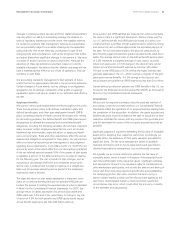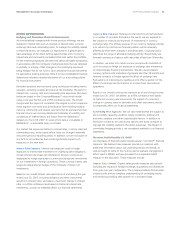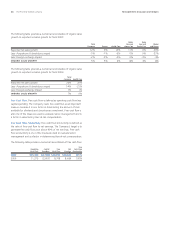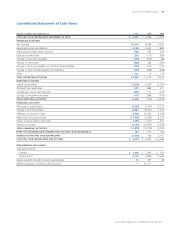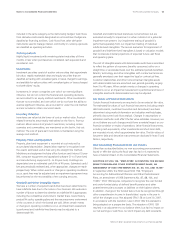Proctor and Gamble 2007 Annual Report Download - page 48
Download and view the complete annual report
Please find page 48 of the 2007 Proctor and Gamble annual report below. You can navigate through the pages in the report by either clicking on the pages listed below, or by using the keyword search tool below to find specific information within the annual report.The Procter & Gamble Company
46 Management’s Discussion and Analysis
Determining the useful life of an intangible asset also requires judgment.
Certain brand intangibles are expected to have indenite lives based
on their history and our plans to continue to support and build the
acquired brands. Other acquired brands are expected to have
determinable useful lives. Our assessment as to brands that have an
indenite life and those that have a determinable life is based on a
number of factors including competitive environment, market share,
brand history, underlying product life cycles, operating plans and the
macroeconomic environment of the countries in which the brands are
sold. Our estimates of the useful lives of determinable-lived intangibles,
primarily including brands, technologies and customer relationships,
are primarily based on these same factors. All of our acquired
technology and customer-related intangibles are expected to have
determinable useful lives.
Other signicant estimates associated with the accounting for
acquisitions include exit costs. Provided certain criteria are met, exit
costs related to acquired operations are treated as assumed liabilities.
If those criteria are not met, the costs are treated as operating expenses
of the combined company as incurred. Exit costs, consisting primarily
of severance costs, facility closure and other exit costs related to
redundant manufacturing, selling, general and administrative functions,
are based upon plans that have been committed to by management
but which are subject to renement. Signicant estimates and
assumptions inherent in the calculation of exit costs relate to the
number of employees that will be terminated, future costs to operate
and eventually vacate duplicate facilities and costs to terminate
agreements. These estimates and assumptions may change as we
execute approved plans. Decreases to the estimated costs are generally
recorded as an adjustment to goodwill. Increases to the estimates are
generally recorded as an adjustment to goodwill during the purchase
price allocation period (generally within one year of the acquisition
date) and as operating expenses thereafter.
Acquired intangible assets may represent indenite-lived assets
(e.g., certain trademarks or brands), determinable-lived intangibles
(e.g., patents and technologies) or residual goodwill. Of these, only
the costs of determinable-lived intangibles are amortized to expense
over their estimated life. The value of indenite-lived intangible assets
and residual goodwill is not amortized, but is tested at least annually
for impairment. Our impairment testing for goodwill is performed
separately from our impairment testing of indenite-lived intangibles.
We test goodwill for impairment, at least annually, by reviewing the
book value compared to the fair value at the reportable unit level.
We test individual indenite-lived intangibles at least annually by
reviewing the individual book values compared to the fair value.
Considerable management judgment is necessary to evaluate the
impact of operating and macroeconomic changes and to estimate
future cash ows to measure fair value. Assumptions used in the
Company’s impairment evaluations, such as forecasted growth rates
and cost of capital, are consistent with internal projections and
operating plans. We believe such assumptions and estimates are also
comparable to those that would be used by other market participants.
When certain events or changes in operating conditions occur,
indenite-lived intangible assets may be adjusted to a determinable
life and an additional impairment assessment may be performed.
We did not recognize any material impairment charges for goodwill
or intangible assets during the years presented.
The recorded value of goodwill and intangible assets from recently
acquired businesses are derived from more recent business operating
plans and macroeconomic environmental conditions and therefore
are more susceptible to an adverse change that could require an
impairment charge. Indenite-lived intangible assets totaled $27.0 billion
at June 30, 2007, of which $23.9 billion represent recently acquired
Gillette intangible assets. The Gillette indenite-lived intangible assets
were recorded at estimated fair values as of the acquisition date. Total
goodwill is $56.6 billion at June 30, 2007, of which $35.3 billion results
from the Gillette acquisition. Such goodwill reects the residual amount
from a purchase price allocation as of the acquisition date. Because
the Gillette intangible and goodwill amounts represent current values
as of the relatively recent acquisition date, such amounts are more
susceptible to an impairment risk if business operating results or
macroeconomic conditions deteriorate.
As more fully discussed in Notes 1 and 9 to the Consolidated Financial
Statements, we adopted SFAS 158, “Employers’ Accounting for Dened
Benet Pension and Other Postretirement Plans, an amendment of
FASB Statements No. 87, 88, 106, and 132(R),” at June 30, 2007.
SFAS 158 requires companies to recognize the over-funded and under-
funded status of dened benet pension and other postretirement
plans as assets or liabilities on their balance sheets and to recognize
previously unrecognized changes in that funded status, in the year in
which changes occur, through other comprehensive income in
shareholders’ equity.
In July 2006, the FASB issued FASB Interpretation (FIN) 48, “Accounting
for Uncertainty in Income Taxes.” FIN 48 addresses the accounting
and disclosure of uncertain tax positions. FIN 48 prescribes a recognition
threshold and measurement attribute for the nancial statement
recognition and measurement of a tax position taken or expected to
be taken in a tax return. We will adopt FIN 48 on July 1, 2007. We
estimate that the adoption of FIN 48 will result in a net decrease to
beginning retained earnings of approximately $200 – $250 million,
primarily related to the accrual of additional interest and penalties on
unrecognized tax benets.
No other new accounting pronouncement issued or effective during
the scal year has had or is expected to have a material impact on the
Consolidated Financial Statements.











